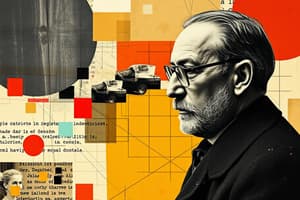Podcast
Questions and Answers
What is the primary idea behind Transformative Generative Grammar?
What is the primary idea behind Transformative Generative Grammar?
- Language is acquired through experience and interaction
- Language is a natural ability that develops over time
- Language is innate and humans have an innate capacity for generating an infinite number of sentences (correct)
- Language is learned through formal education
What is the term for the underlying, abstract representation of a sentence?
What is the term for the underlying, abstract representation of a sentence?
- Type 1 Grammar
- Transformation
- Surface Structure
- Deep Structure (correct)
What type of transformation rearranges the order of words or phrases?
What type of transformation rearranges the order of words or phrases?
- Context-Sensitive Transformation
- Insertion Transformation
- Movement Transformation (correct)
- Deletion Transformation
What is the term for the physical representation of a sentence as spoken or written?
What is the term for the physical representation of a sentence as spoken or written?
What is the highest level of grammar in Chomsky's Hierarchy?
What is the highest level of grammar in Chomsky's Hierarchy?
What is the term for the idea that children are not exposed to enough linguistic data to learn a language?
What is the term for the idea that children are not exposed to enough linguistic data to learn a language?
What is the term for the idea that language is innate?
What is the term for the idea that language is innate?
Who developed the theory of Transformative Generative Grammar?
Who developed the theory of Transformative Generative Grammar?
Flashcards are hidden until you start studying
Study Notes
Transformative Generative Grammar
Definition
- A theoretical framework in linguistics that posits that language is innate and that humans have an innate capacity for generating an infinite number of sentences from a finite set of rules.
- Developed by Noam Chomsky in the 1950s and 1960s.
Key Components
- Deep Structure: The underlying, abstract representation of a sentence that captures its meaning and relationships between words.
- Surface Structure: The actual, physical representation of a sentence as spoken or written.
- Transformation: A rule that converts a deep structure into a surface structure, altering the sentence's form while preserving its meaning.
Types of Transformations
- Movement Transformations: Rearrange the order of words or phrases, such as passive voice or question formation.
- Insertion Transformations: Add words or phrases to a sentence, such as inserting "do" in a sentence to form a question.
- Deletion Transformations: Remove words or phrases from a sentence, such as reducing a sentence to its essential components.
Chomsky's Hierarchy
- Type 0: Unrestricted grammar, capable of generating all possible sentences.
- Type 1: Context-sensitive grammar, where the application of a rule depends on the context in which it is applied.
- Type 2: Context-free grammar, where the application of a rule is independent of context.
- Type 3: Regular grammar, where the application of a rule is based on a finite number of states.
Criticisms and Controversies
- Innateness Hypothesis: The idea that language is innate has been challenged by some linguists, who argue that language is acquired through experience and interaction.
- Poverty of the Stimulus: The argument that children are not exposed to enough linguistic data to learn a language, and therefore must have an innate capacity for language acquisition.
- Linguistic Universals: The idea that there are universal principles and patterns that underlie all human languages has been challenged by some linguists, who argue that language is more diverse and varied than previously thought.
Transformative Generative Grammar
Definition
- A theoretical framework in linguistics that proposes language is innate and humans have an innate capacity for generating an infinite number of sentences from a finite set of rules.
- Developed by Noam Chomsky in the 1950s and 1960s.
Key Components
- Deep Structure: Captures the underlying meaning and relationships between words in a sentence.
- Surface Structure: The physical representation of a sentence as spoken or written.
- Transformation: A rule that converts a deep structure into a surface structure, altering the sentence's form while preserving its meaning.
Types of Transformations
- Movement Transformations: Rearrange the order of words or phrases (e.g., passive voice or question formation).
- Insertion Transformations: Add words or phrases to a sentence (e.g., inserting "do" in a sentence to form a question).
- Deletion Transformations: Remove words or phrases from a sentence (e.g., reducing a sentence to its essential components).
Chomsky's Hierarchy
- Type 0: Unrestricted grammar, capable of generating all possible sentences.
- Type 1: Context-sensitive grammar, where the application of a rule depends on the context.
- Type 2: Context-free grammar, where the application of a rule is independent of context.
- Type 3: Regular grammar, where the application of a rule is based on a finite number of states.
Criticisms and Controversies
- Innateness Hypothesis: The idea that language is innate has been challenged by some linguists, who argue that language is acquired through experience and interaction.
- Poverty of the Stimulus: The argument that children are not exposed to enough linguistic data to learn a language, and therefore must have an innate capacity for language acquisition.
- Linguistic Universals: The idea that there are universal principles and patterns that underlie all human languages has been challenged by some linguists, who argue that language is more diverse and varied than previously thought.
Studying That Suits You
Use AI to generate personalized quizzes and flashcards to suit your learning preferences.



